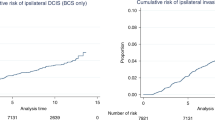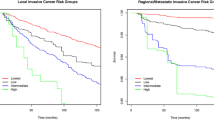Abstract
Background
Screening mammography has increased the number of patients diagnosed with ductal carcinoma-in-situ (DCIS) in the past 20 years. The Florida Cancer Data System is the largest single source incident cancer registry in the United States. We analyzed this registry to determine the changing incidence and treatment patterns for DCIS.
Methods
Patients with DCIS from 1981 to 2001 were identified. Age-adjusted rate, descriptive statistics, and incidence of future DCIS and invasive breast cancer were calculated.
Results
A total of 23,810 DCIS patients were identified. The age-adjusted rate of DCIS has risen from 2.4 to 27.7 per 100,000 women between 1981 and 2001. Median age was 64 years; 85% of patients were white, 6.6% African American, and 7.5% Hispanic. Median tumor size was .9 cm. Forty-seven percent of patients had breast-conserving therapy (BCT). Half of the 53% of patients undergoing mastectomy underwent a modified radical mastectomy. Eight percent received no surgical treatment. Sentinel lymph node biopsy was used in 2.7% of patients who underwent a mastectomy. After BCT, 37.5% received adjuvant radiotherapy, and only 13% were treated with hormonal therapy.
Conclusions
The incidence of DCIS has risen dramatically with the advent of screening mammography. Increasing numbers of these patients are treated with BCT, although a large proportion are still treated with mastectomy, in some cases combined with axillary dissection. Sentinel lymph node biopsy and tamoxifen are important components of therapy, the use of which is slowly increasing in the treatment of DCIS.



Similar content being viewed by others
References
Betsill WL Jr, Rosen PP, Lieberman PH, Robbins GF. Intraductal carcinoma. Long-term follow-up after treatment by biopsy alone. JAMA 1978; 239:1863–1867
Nakhlis F, Morrow M. Ductal carcinoma in situ. Surg Clin North Am 2003; 83:821–839
Fisher B. From Halsted to prevention and beyond: advances in the management of breast cancer during the twentieth century. Eur J Cancer 1999; 35:1963–1973
Carrera C, Payne S. Ductal carcinoma in situ (DCIS) of the breast: the need for psychosocial research. Psychooncology 1999; 8:538–545
Schootman M, Aft R. Rural-urban differences in radiation therapy for ductal carcinoma-in-situ of the breast. Breast Cancer Res Treat 2001; 68:117–125
Schootman M, Kinman E, Farria D. Rural-urban differences in ductal carcinoma in situ as a proxy for mammography use over time. J Rural Health 2003; 19:470–476
Simon MS, Lemanne D, Schwartz AG, Martino S, Swanson GM. Recent trends in the incidence of in situ and invasive breast cancer in the Detroit metropolitan area (1975–1988). Cancer 1993; 71:769–774
Wu X, Chen VW, Ruiz B, et al. Patterns of treatment for ductal carcinoma in situ of the breast in Louisiana, 1988–1999. J La State Med Soc 2003; 155:206–213
Wood WC. The role of clinical trials in changing therapy for ductal carcinoma in situ. Ann Surg Oncol 2004; 11:24S–27S
Ernster VL, Barclay J, Kerlikowske K, Grady D, Henderson C. Incidence of and treatment for ductal carcinoma in situ of the breast. JAMA 1996; 275:913–918
Ernster VL, Barclay J, Kerlikowske K, Wilkie H, Ballard-Barbash R. Mortality among women with ductal carcinoma in situ of the breast in the Population-Based Surveillance, Epidemiology and End Results Program. Arch Intern Med 2000; 160:953–958
Collette C. A multidisciplinary approach to breast biopsy. AORN J 1999; 69:810–811
Bodai BI, Boyd B, Brown L, Wadley H, Zannis VJ, Holzman M. Total cost comparison of 2 biopsy methods for nonpalpable breast lesions. Am J Manag Care 2001; 7:527–538
Secker-Walker RH, Vacek PM, Hooper GJ, Plante DA, Detsky AS. Screening for breast cancer: time, travel, and out-of-pocket expenses. J Natl Cancer Inst 1999; 91:702–708
Liberman L, Feng TL, Dershaw DD, Morris EA, Abramson AF. US-guided core breast biopsy: use and cost-effectiveness. Radiology 1998; 208:717–723
Brenner RJ, Sickles EA. Surveillance mammography and stereotactic core breast biopsy for probably benign lesions: a cost comparison analysis. Acad Radiol 1997; 4:419–425
Kerlikowske K, Barclay J, Grady D, Sickles EA, Ernster V. Comparison of risk factors for ductal carcinoma in situ and invasive breast cancer. J Natl Cancer Inst 1997; 89:76–82
Cox CE, Nguyen K, Gray RJ, et al. Importance of lymphatic mapping in ductal carcinoma in situ (DCIS): why map DCIS? Am Surg 2001; 67:513–519
Dupont EL, Kuhn MA, McCann C, Salud C, Spanton JL, Cox CE. The role of sentinel lymph node biopsy in women undergoing prophylactic mastectomy. Am J Surg 2000; 180:274–277
Klauber-Demore N, Tan LK, Liberman L, et al. Sentinel lymph node biopsy: is it indicated in patients with high-risk ductal carcinoma-in-situ and ductal carcinoma-in-situ with microinvasion? Ann Surg Oncol 2000; 7:636–642
Baxter NN, Virnig BA, Durham SB, Tuttle TM. Trends in the treatment of ductal carcinoma in situ of the breast. J Natl Cancer Inst 2004; 96:443–448
Fisher B, Costantino J, Redmond C, et al. Lumpectomy compared with lumpectomy and radiation therapy for the treatment of intraductal breast cancer. N Engl J Med 1993; 328:1581–1586
Fisher B, Dignam J, Wolmark N, et al. Lumpectomy and radiation therapy for the treatment of intraductal breast cancer: findings from National Surgical Adjuvant Breast and Bowel Project B-17. J Clin Oncol 1998; 16:441–452
Fisher B, Land S, Mamounas E, Dignam J, Fisher ER, Wolmark N. Prevention of invasive breast cancer in women with ductal carcinoma in situ: an update of the national surgical adjuvant breast and bowel project experience. Semin Oncol 2001; 28:400–418
Fisher B, Bryant J, Dignam JJ, et al. Tamoxifen, radiation therapy, or both for prevention of ipsilateral breast tumor recurrence after lumpectomy in women with invasive breast cancers of one centimeter or less. J Clin Oncol 2002; 20:4141–4149
Fisher ER, Sass R, Fisher B, Wickerham L, Paik SM. Pathologic findings from the National Surgical Adjuvant Breast Project (Protocol 6). I. Intraductal carcinoma (DCIS). Cancer 1986; 57:197–208
Fisher ER, Leeming R, Anderson S, Redmond C, Fisher B. Conservative management of intraductal carcinoma (DCIS) of the breast. Collaborating NSABP investigators. J Surg Oncol 1991; 47:139–147
Fisher ER, Dignam J, Tan-Chiu E, et al. Pathologic findings from the National Surgical Adjuvant Breast Project (NSABP). Eight-year update of Protocol B-17: intraductal carcinoma. Cancer 1999; 86:429–438
Silverstein MJ, Poller DN, Waisman JR, et al. Prognostic classification of breast ductal carcinoma-in-situ. Lancet 1995; 345:1154–1157
Silverstein MJ, Lagios MD, Craig PH, et al. A prognostic index for ductal carcinoma in situ of the breast. Cancer 1996; 77:2267–2274
Silverstein MJ. The University of Southern California/Van Nuys prognostic index for ductal carcinoma in situ of the breast. Am J Surg 2003; 186:337–343
Author information
Authors and Affiliations
Corresponding author
Additional information
Published by Springer Science+Business Media, Inc. © 2006 The Society of Surgical Oncology, Inc.
Rights and permissions
About this article
Cite this article
Sumner, W.E., Koniaris, L.G., Snell, S.E. et al. Results of 23,810 Cases of Ductal Carcinoma-in-situ . Ann Surg Oncol 14, 1638–1643 (2007). https://doi.org/10.1245/s10434-006-9316-1
Received:
Accepted:
Published:
Issue Date:
DOI: https://doi.org/10.1245/s10434-006-9316-1




